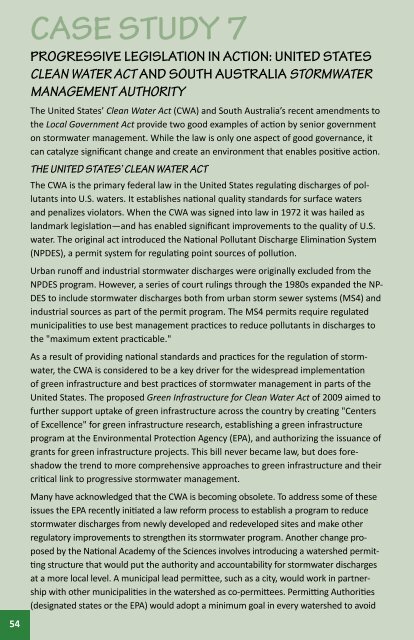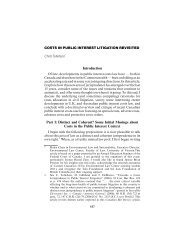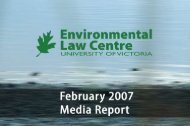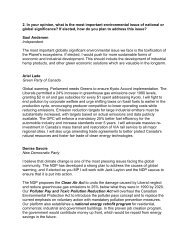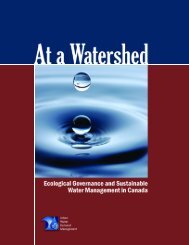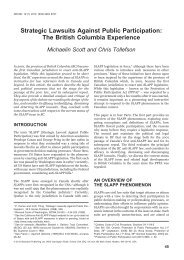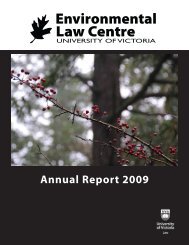Peeling back the Pavement - POLIS Water Sustainability Project
Peeling back the Pavement - POLIS Water Sustainability Project
Peeling back the Pavement - POLIS Water Sustainability Project
You also want an ePaper? Increase the reach of your titles
YUMPU automatically turns print PDFs into web optimized ePapers that Google loves.
54<br />
CASE STUDY 7<br />
PROGRESSIVE LEGISLATION IN ACTION: UNITED STATES<br />
CLEAN WATER ACT AND SOUTH AUSTRALIA STORMWATER<br />
MANAGEMENT AUTHORITY<br />
The United States’ Clean <strong>Water</strong> Act (CWA) and South Australia’s recent amendments to<br />
<strong>the</strong> Local Government Act provide two good examples of action by senior government<br />
on stormwater management. While <strong>the</strong> law is only one aspect of good governance, it<br />
can catalyze significant change and create an environment that enables positive action.<br />
The United States’ Clean <strong>Water</strong> Act<br />
The CWA is <strong>the</strong> primary federal law in <strong>the</strong> United States regulating discharges of pollutants<br />
into U.S. waters. It establishes national quality standards for surface waters<br />
and penalizes violators. When <strong>the</strong> CWA was signed into law in 1972 it was hailed as<br />
landmark legislation—and has enabled significant improvements to <strong>the</strong> quality of U.S.<br />
water. The original act introduced <strong>the</strong> National Pollutant Discharge Elimination System<br />
(NPDES), a permit system for regulating point sources of pollution.<br />
Urban runoff and industrial stormwater discharges were originally excluded from <strong>the</strong><br />
NPDES program. However, a series of court rulings through <strong>the</strong> 1980s expanded <strong>the</strong> NP-<br />
DES to include stormwater discharges both from urban storm sewer systems (MS4) and<br />
industrial sources as part of <strong>the</strong> permit program. The MS4 permits require regulated<br />
municipalities to use best management practices to reduce pollutants in discharges to<br />
<strong>the</strong> "maximum extent practicable."<br />
As a result of providing national standards and practices for <strong>the</strong> regulation of stormwater,<br />
<strong>the</strong> CWA is considered to be a key driver for <strong>the</strong> widespread implementation<br />
of green infrastructure and best practices of stormwater management in parts of <strong>the</strong><br />
United States. The proposed Green Infrastructure for Clean <strong>Water</strong> Act of 2009 aimed to<br />
fur<strong>the</strong>r support uptake of green infrastructure across <strong>the</strong> country by creating "Centers<br />
of Excellence" for green infrastructure research, establishing a green infrastructure<br />
program at <strong>the</strong> Environmental Protection Agency (EPA), and authorizing <strong>the</strong> issuance of<br />
grants for green infrastructure projects. This bill never became law, but does foreshadow<br />
<strong>the</strong> trend to more comprehensive approaches to green infrastructure and <strong>the</strong>ir<br />
critical link to progressive stormwater management.<br />
Many have acknowledged that <strong>the</strong> CWA is becoming obsolete. To address some of <strong>the</strong>se<br />
issues <strong>the</strong> EPA recently initiated a law reform process to establish a program to reduce<br />
stormwater discharges from newly developed and redeveloped sites and make o<strong>the</strong>r<br />
regulatory improvements to streng<strong>the</strong>n its stormwater program. Ano<strong>the</strong>r change proposed<br />
by <strong>the</strong> National Academy of <strong>the</strong> Sciences involves introducing a watershed permitting<br />
structure that would put <strong>the</strong> authority and accountability for stormwater discharges<br />
at a more local level. A municipal lead permittee, such as a city, would work in partnership<br />
with o<strong>the</strong>r municipalities in <strong>the</strong> watershed as co-permittees. Permitting Authorities<br />
(designated states or <strong>the</strong> EPA) would adopt a minimum goal in every watershed to avoid


